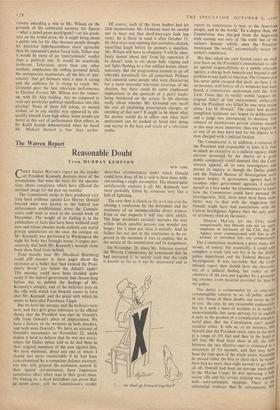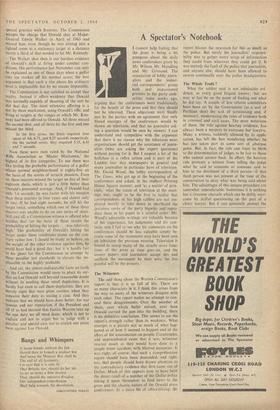The Warren Report
Reasonable Doubt
Front MURRAY KEMPTON
NEW YORK
1-11EF Justice Warren's report on the murder
of President Kennedy destroys most of the assumptions that were the basis for the specula- tions about conspiracy which have afflicted the national image for the past ten months.
The Commission seems to have produced very little hard evidence against Lee Harvey Oswald beyond what was known to the federal law enforcement establishment when the Commis- sion's staff went to work in the second week of December. The weight of its finding is in the publication of facts that have been withheld until now and whose absence made unlikely any useful private speculation on the case. An autopsy on Mr. Kennedy was performed in Washington the night his body was brought home; it argues per- suasively that both Mr. Kennedy's wounds came from shots fired from behind.
Four months later Mr. Mordecai Brienberg could still wonder in these pages about the existence of a bullet that 'had entered the Presi- dent's throat' just below the, Adam's apple! This mistake could have been avoided quite easily if the federal government had chosen long before this to publish the findings of Mr. Kennedy's autopsy, and of the ballistics tests on the rifle with which Lee Oswald seems to have shot Mr..Kennedy and the pistol with which he seems to have shot Patrolman Tippit.
But we have the autopsy and the ballistics tests now, and they give great substance to the official theory that the President was shot by Oswald's rifle from Oswald's place of employment. We have a history of the weapons in both murders, and both were Oswald's. We have an account of Oswald's movements on 'November 22, which makes it hard to believe that he was not every- where the Dallas police told us he had been in their original summary of the case against him. We have witnesses, about any one of whom I should feel more comfortable if he had been cross-examined by a competent defence attorney, but who still, granted the confusion natural in their special circumstances, have impressive cumulative effect when read in their great mass. No finding on a dead defendant can prove that he acted alone; still the Commission's verdict describes circumstances under which Oswald could have done all he is said to have done with- out needing a single accomplice. The absurd quite satisfactorily explains it all. Mr. Kennedy was most probably killed by someone very like a bolt of lightning.
The case then is closed so far as it can ever be, missing, a confession by the defendant and the testimony of an unimpeachable direct witness. Even so one suspects it will stay alive awhile. The huge document certainly narrows the area within which sensible persons can wonder any longer, but it does not close it entirely. And its failure lies not just in the confusions to be ex- pected in the moments it tries to explain, but in the nature of the commission and its assignment.
On November 29, when Mr. Johnson created the Warren Commission, he announced that he had instructed it `to satisfy itself that the truth is known as far as it can be discovered and to we shall go forward together!' report its conclusions to him, to the American people, and to the world.' To a degree then, the Commission was charged from the beginning with custody not only of 'the truth' but of the nation's honour which, once the President mentioned 'the world,' automatically meant the nation's reputation.
We thus asked the only formal court we shall
ever have on the President's assassination to take on special responsibilities as a public relations agency, a charge both beneath and beyond it and perilous to any judicial function. The Commission has never quite escaped that peril, on June I, as an instance, well before all its witnesses had been heard, a commission spokesman told the New York Times that its verdict would 'support the original belief of law enforcement authorities that the President was killed by one man acting alone, Lee H. Oswald.' The court had neither completed testimony nor begun its deliberations and a judge was announcing its decision. The rebuttal of mischievous private citizens seemed to this man more important than any respect he or any of us may have had for his dignity as a man charged with a judicial fuction.
The Commission is, in addition, a creation of the President and responsible to him: it is thus as much an executive as a judicial agency. Only persons possessed by the theory of a great public conspiracy could demand that the Cunt- mission appoint all its own investigators and pursue its inquiry as though the Dallas police and the Federal Bureau of Investigation were suspect bodies. A government agency had to examine other government agencies. I confess myself at a loss under the circumstances to know how the Commission could have pursued the investigations. Still, there must have been some better way to deal with the suggestion that Oswald might have had associations with the Central Intelligence Agency than the only piece of testimony cited on the point :
Director McCone [of the CIA) stated
unequivocally that Oswald was not an ago!. employee or informant of the CIA, that the Agency never communicated with him in anY manner or furnished him . any compensation,
The Commission examined a great many wit'
nesses, of course; but essentially, it could only complete a track laid out for it by the Dallas. police department and the Federal Bureau of Investigation. It was inevitable that the Coln' mission report then should have the character. not of a judicial finding, but rather of the summary of the case put together by a prosecut" ing attorney from •material provided for him by the police.
This defect is compounded by an otherwise commendable concern to set all public doubts to rest. Some of these doubts can never be
to rest: the case, by any reasonable explanation, has in it such a mass of accident as to make tt understandable that some persons try to explain it only as the product of a complicated conspira' torial plan. But the Commission can't accept accident either. It tells us, as an instance, that Oswald shot the President twice, once in the neck at a range of 191 feet and then in the head at 265 feet. He fired three shots in all; the time between the two effective ones is estimated at a maximum of 5.6 seconds, and that may have been the time span of the whole series. Assuming, he missed either the first or third shot, he would have had no more than eight seconds to get therm all off. Oswald had been an average marksman
,
, in the Marine Corps; he was operating a boll action rifle and his service training was entirely with semi-automatic weapons. There is 0, substantial evidence that he subsequently had
special practice with firearms. The Commission accepts the charge that Oswald shot at Major- General Edwin Walker in April of 1963 and missed him, even though he was aiming into a lighted room at a stationary target at a distance barely a third of that needed to hit Mr. Kennedy.
' The Walker shot then is our hardest evidence of Oswald's skill at firing under combat con- ditions. His performance last November can only be explained as one of those days when a golfer cuts ten strokes off his normal score; the best argument is that such a rise above his ordinary level is implausible but by no means impossible.
The Commission is not satisfied to accept that reality. Instead it offers evidence that Oswald Was normally capable of shooting of the sort he did that day. The most extensive offering is a test by three marksmen, using Oswald's rifle, and firing at targets at the ranges at which Mr. Ken- nedy had been offered to Oswald. All three missed the second shot, and all three hit the first and one missed the third.
In the first series, the firers required time spans of 4.6, 6.75, and 8.25 seconds respectively. On the second series, they required 5.15, 6.45 and 7 seconds.
Now these were men rated by the National ' Rifle Association as 'Master Marksmen,' the highest of its five categories. To use them was like testing the probable performance of a golfer
1, whose normal neighbourhood is eighty-five on the basis of the scores of scratch shooters. Even so, these masters missed the target on five of their eighteen shots, which is just a little better than Oswald's presumed average. And, if Oswald had '" only 5.6 seconds, he was, faster with his weapon than these masters in four cases and slower only in two. If he had eight seconds, he still hit the target twice, something which one of these three masters was unable to do on one series of shots. Still and all, a Commission witness is offered who testifies that 'on the' basis of these results the Probability of hitting the targets ... was relatively high.' The probability of Oswald's hitting the target under these conditions seems on the con- trary rather low. I should be ready to believe, on the weight of the other evidence against him. he could have had a good day; but it is hardly fair to his ghost for the Commission to attempt by these peculiar test standards to elevate the im- Plausible to the highly probable.
And yet, the almost-indisputable facts set forth by the Commission would seem to place its ver- dict on Lee Oswald well beyond reasonable doubt without its needing these small duplicities. It is hardly fair even to call them-duplicities; they are merely signs that men grow careless when they conceive their duty as stating a case. And they indicate that we would have done better, for our honour and our reputation, if the President and all of us had insisted that Justice Warren take up the one duty we all need done, which is not to explain and not to argue but to judge with a peculiar and special care not to stretch one point even against Lee Oswald.















































 Previous page
Previous page